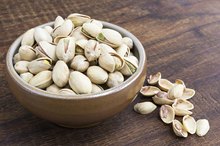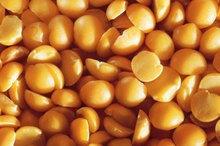Hazelnut Allergy
Food allergies can be debilitating conditions that limit not only your diet but your exposure to other products as well. Hazelnut allergy is a result of an immune reaction that attacks proteins in the nut. This triggers a production of immune chemicals, including antibodies and histamine, that cause the symptoms typical of allergic reactions. To avoid a reaction, avoid exposure to hazelnuts and other particles that may trigger the allergy. Consult your doctor if you suspect you are allergic to hazelnuts.
Hazelnut
Hazelnut is categorized as a tree nut, together with nuts such as almonds, Brazil nut, pecans and cashews. Although tree nuts are similar, they do come from different and unrelated nut families. Hazelnut belongs to the birch family, as do the hickory nut and filbert. If you are allergic to hazelnuts, you typically also are allergic to the other birch nuts, but might not be allergic to the other tree nut families, according to Dr. Anthony Pong, a lecturer in the department of pediatrics at the University of Ottawa.
- Hazelnut is categorized as a tree nut, together with nuts such as almonds, Brazil nut, pecans and cashews.
- Hazelnut belongs to the birch family, as do the hickory nut and filbert.
Cross-Reaction
Can I Eat Coconuts if I am Allergic to Nuts?
Learn More
Besides getting an allergic reaction when you eat foods that contain hazelnuts, you may also get a reaction to tree pollen. Hazelnut allergy is common in people who are allergic to birch, alder and hazel pollen, according to the Food-Info website, which is an initiative of the Wageningen University. This reactivity between pollen and hazelnut is also known as "food-pollen allergy" or "oral allergy syndrome," which is the effect of cross-reactivity between tree pollen and hazelnut proteins.
Symptoms
Symptoms of hazelnut allergy include blotching, hives, runny nose, watery eyes, choking, asthma symptoms (such as wheezing and difficulty in breathing), vomiting, cramps, diarrhea and swelling, itching, and burning of the mouth, throat or face. Symptoms usually manifest immediately after you consume hazelnut-containing products. Allergic reactions can cease at any time, but they can also progress to a more severe reaction known as anaphylactic shock. Anaphylaxis affects the entire body and can eventually be fatal unless treated with an injection of epinephrine.
- Symptoms of hazelnut allergy include blotching, hives, runny nose, watery eyes, choking, asthma symptoms (such as wheezing and difficulty in breathing), vomiting, cramps, diarrhea and swelling, itching, and burning of the mouth, throat or face.
Prevention
Symptoms of Allergies to Chickpeas and Soy
Learn More
If you are diagnosed with hazelnut allergy, you must completely avoid all foods and beverages that contain hazelnuts and other birch nuts. If you also are allergic to other nuts, you need to avoid these as well. Common foods and drinks that contain hazelnut include baked goods, cereals, hazelnut coffee, hazelnut liqueur, chocolate, nougat and hazelnut spread. However, hazelnuts are not easily detectable and trace amounts can be found in foods that have been manufactured in a factory that also processes foods that contain hazelnuts. Allergic reactions are frequently the result of such cross-contaminated products, according to Dr. Pong. Typical items that may trigger an allergic reaction include ice cream, nut breads, cookies, granola bars, candies, suntan lotions, bath oils and shampoos.
- If you are diagnosed with hazelnut allergy, you must completely avoid all foods and beverages that contain hazelnuts and other birch nuts.
- However, hazelnuts are not easily detectable and trace amounts can be found in foods that have been manufactured in a factory that also processes foods that contain hazelnuts.
Related Articles
References
- MayoClinic.com; Allergies; January 2011
- Calgary Allergy Network; Tree Nut Allergies; Antony Ham Pong
- Food-Info: Hazelnut Allergy
- Mcwilliam V, Koplin J, Lodge C, Tang M, Dharmage S, Allen K. The Prevalence of Tree Nut Allergy: A Systematic Review. Curr Allergy Asthma Rep. 2015;15(9):54. doi:10.1007/s11882-015-0555-8
- Lomas JM, Järvinen KM. Managing nut-induced anaphylaxis: challenges and solutions. J Asthma Allergy. 2015;8:115–123. doi:10.2147/JAA.S89121
- Muluk NB, Cingi C. Oral allergy syndrome. Am J Rhinol Allergy. 2018;32(1):27-30.
- Kashyap RR, Kashyap RS. Oral Allergy Syndrome: An Update for Stomatologists. J Allergy (Cairo). 2015;2015:543928. doi:10.1155/2015/543928
- Kemp SF, Lockey RF, Simons FE; World Allergy Organization ad hoc Committee on Epinephrine in Anaphylaxis. Epinephrine: the drug of choice for anaphylaxis-a statement of the world allergy organization. World Allergy Organ J. 2008;1(7 Suppl):S18–S26. doi:10.1097/WOX.0b013e31817c9338
- Brown JC. Epinephrine, auto-injectors, and anaphylaxis: Challenges of dose, depth, and device. Ann Allergy Asthma Immunol. 2018;121(1):53-60. doi:10.1016/j.anai.2018.05.001
- NIAID-Sponsored Expert Panel. Guidelines for the Diagnosis and Management of Food Allergy in the United States: Report of the NIAID-Sponsored Expert Panel. The Journal of Allergy and Clinical Immunology. Volume 126, Issue 6, Supplement, Pages S1-S58, December 2010
- American Academy of Allergy, Asthma and Immunology. "The different faces of hazelnut allergy across Europe." Published online March 14, 2015.
- Food Allergy Initiative. Tree Nut Allergy.
- Geroldinger-Simic, M, et al. Birch pollen-related food allergy: Clinical aspects and the role of allergen-specific IgE and IgG4 antibodies. J Allergy Clin Immunology. Vol. 127, No. 3
- Webber, Christopher and Ronald W. England. Oral allergy syndrome: a clinical, diagnostic, and therapeutic challenge. Ann Allergy Asthma Immunol. 2010;104:101-108
Writer Bio
Maria Hoven is a health and fitness expert with over 10 years of expertise in medical research. She began writing professionally in 2004 and has written for several websites including Wound Care Centers and healthnews.org. Hoven is earning a Doctor of Philosophy in cell and molecular biology from the University of Nevada, Reno.









